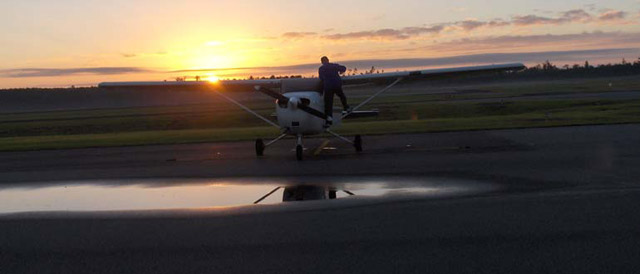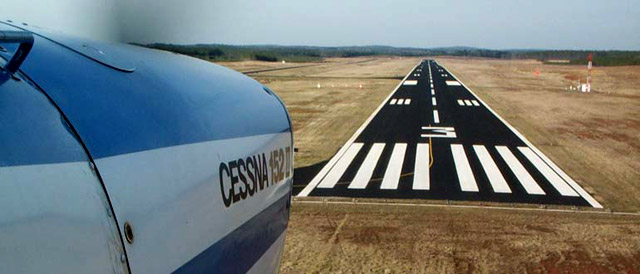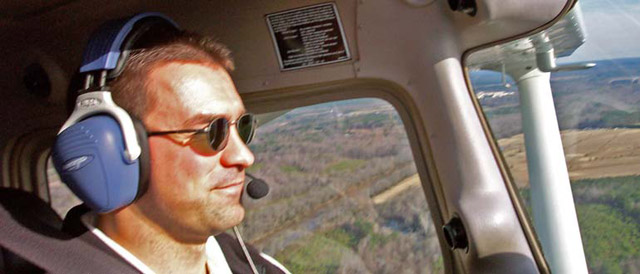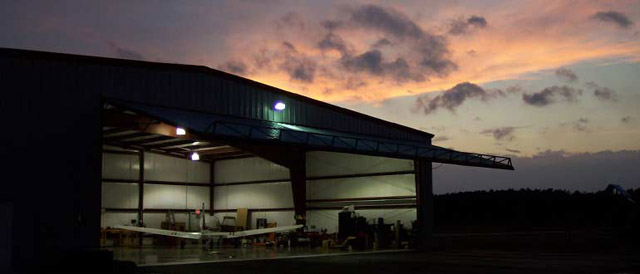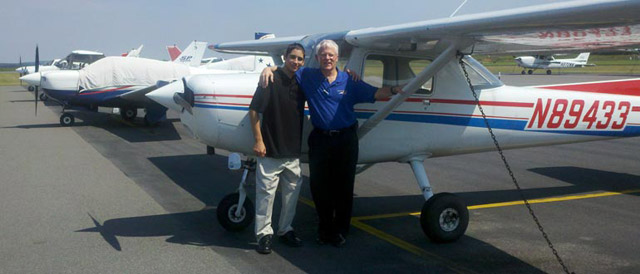We start the year by featuring the Wings of Carolina Flying Club. Based at Raleigh Executive Jetport at Sanford-Lee County (KTTA) in North Carolina, the club operates 13 aircraft and has more than 350 members. Here is our Q&A with Club President Jan Squillace:
Factsheet
| Name | Wings of Carolina |
| Location | Raleigh Executive Jetport at Sanford-Lee County (KTTA), Sanford, NC |
| Website | |
| Year formed | 1961 |
| Aircraft | 4 - Cessna 152s ($74/hr.) |
| Joining fee | $200 application fee |
| Monthly dues | $65 per month/$15 per month for inactive members/$20 per month for associate members |
| Membership | 365 |
| Scheduler | MyFBO.com |
Can you explain your membership structure?
We have three categories of membership. One of them is called Full Member, and that’s for someone who flies our airplanes, including student pilots.
There’s one called Member, which is what we use for folks who are gone for a number of months. We have some snowbirds who are here in the summertime and gone in the winter. You keep your airplane deposit with the club, but your dues drop to $15 a month while you’re gone. When you come back there’s no problem to flip your status back to Full Member and immediately start flying. This category also includes active-duty servicemen that are deployed. We don’t charge them dues while they’re gone.
Finally there’s an Associate Member, which can be someone who doesn’t fly at all but wants to be associated with the club. It also includes people who own their own airplane but like to have access to our clubhouse, social activities, simulator, and our discount pilot supplies.
Right now we have approximately 200 full members, 135 members and 30 associate members.
Tell us about your aircraft and how are they equipped
We operate four types of aircraft. Within each type, we like to have all the aircraft equipped equivalently so that you can move from one aircraft to another. So it doesn’t matter which 152 you get, they’re all the same. In total there are thirteen aircraft – nine are owned by the club and four are leased.
Last year we went through a project where we removed all the ancient KLN-94s and Apollo GX-60s, and upgraded them all with GTN 650s. Now we have the same GPS in the Warriors and the 172s, we’re finding people switching between the two types much more easily than they used to.
We also put a GTN 750 in our new Mooney. The interface is the same as the 650; it just has a bigger screen. This will help people move up from the mid-range fleet, the Warriors and the 172s, to the high-end fleet, the Mooney’s.
One of the big reasons we keep the Mooney’s is for commercial training. We could get Cirrus’s or something else that’s fixed gear, but then we wouldn’t have anything for commercial training.
Can you explain your fee structure?
There is a $200 application fee and dues are $65 a month for Full Members. There is also a security deposit. You get it back when you leave the club. For the Cessna 152s it’s $300, for the Piper Warriors it’s $600, for the 172s it’s $900 and for the Mooney’s it’s $1,200.
If a pilot wanted to fly all four types of aircraft, you just pay the Mooney deposit and that covers everything below that.
We have a base rate for each airplane type, and then we have a fuel surcharge and that varies from week to week, depending on what are latest fuel bills are. It gets updated whenever I get an email from the FBO telling me what we’ve paid for fuel. Everybody appreciates that whatever the best price was that we could get on fuel, that’s what we charged the members. That’s our thing—safe, affordable, flying.
We make sure the base rates cover all the fixed stuff, like engine replacement, interiors, repainting, and sometimes avionics.
Can you explain your organizational structure?
We’re basically volunteer run. We had a paid manager at one point and decided that just wasn’t going to work out. The board is elected and then the key volunteers, the people that run everything, they are appointed by the board. Key volunteers put in a lot of hours to the club, but the advantage is they don’t have to pay dues.
We have a part time book keeper who mans the front desk a couple days a week and does all the financial transactions and pays the bills and that sort of stuff. We have a volunteer treasurer who overseas all that.
How do you handle maintenance?
We have one full-time and one part-time A&P on site. The chief maintenance guy has a big board in his office where he keeps up with how many hours and the status of all the airplanes. We do 50-hour inspections. Hardly anything really critical can happen in 50 hours.
We also have maintenance volunteers, five or six who come out regularly every week. They work under the supervision of the chief A&P guy.
How do you finance maintenance and aircraft upgrades?
We have reserve accounts for each aircraft type for engine replacement, paint and interiors, and we’re in the process of coming up with a schedule that every so often these airplanes need to be done.
In the past we’ve taken out a loan to pay for that kind of stuff. But with the number of members we’ve had recently, we’ve been able to do better financially and put away a reserve. When we need to have an engine, we just go out and buy it and pay cash.
When we upgraded the GPS’s, it was a big project, $20,000 an airplane for six airplanes. To make the conversion I wanted to do it on our schedule not a panic mode.
Talk us through your insurance program
Sutton James is the broker, Phoenix the underwriter, and we do it based on the number of hours flown.
We send the actual Hobbs numbers each month and then they bill us. So if we fly a lot, we pay more insurance but we’re also getting more revenue. If we fly less, we pay less in insurance.
We have what’s called $2 million smooth on each member. That means there are no sub-limits, no $100,000 per seat. It’s $2 million, period. We had to raise the dues from $60 to $65 a month to cover it, but everybody seemed to feel this was well worth it. There is a $1,500 deductible that if you have an incident or an accident with the airplane, you’re responsible for up to $1,500, over and above your security deposit. This gives folks some skin in the game to be careful, but it’s not so much that it’s going to break somebody.
Tell us about your facilities
We have our own building. It is a good size maintenance hangar, so we do all of our maintenance indoors, which is lovely. We have a pretty good size classroom, it holds about 100 people when we take all the tables out and put in chairs, and a full kitchen. We use the classroom for our ground schools; we do meetings there, outside events, Wings programs, and flight instructor seminars. Our classroom is a very busy place.
How many times a year do you run your ground school?
We do a private ground school three times a year starting in January, May and September. In January we have an instrument ground school and in September we do a commercial ground school.
These ground schools are the lifeblood of our club. I would say probably 80 percent of our new members come from our student pilots. Right now there are about 60 student pilots. We have over a dozen instructors. The hourly rate, the instructors keep all of it. The instructors are happy because they’re actually making more than they would someplace else, and the students are happy because they are paying less.
Do you have a full service pilot shop?
Pretty much. It’s mostly educational materials that we carry, books for the ground schools and charts. We have enough volume in paper charts that we have our own NACO [FAA National Aeronautical Charting Office] account. We carry one line of headsets and flight bags. We sell everything at wholesale because we’re only selling to members. We’re a Sporty’s dealer and get materials from Sporty’s.
What type of social activities do you have?
In terms of social aspect, every month on the second Saturday we have a cookout. It started out as just a social for the members, but it has turned out into a marvelous recruiting tool. We also schedule airplane washes, and being here in the south we can wash airplanes pretty much every month of the year.
Every even month we have safety seminars, five of those a year and then the sixth one in December is our club elections and club business meeting. On the odd months, we had a number of presentations on iPad and applications for the iPad, and GPSs and handheld GPSs and what not. Whatever people are interested in, we’ll put together a technical seminar.
We also do three or four Club Trips a year, including a club trip to Oshkosh every year. Six or seven aircraft usually go.
